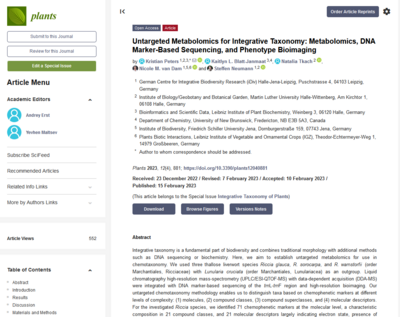Taxonomy with chemistry: phylogenetic tree of liverwort metabolites.
The characterization and classification of biological species is a fundamental component of biodiversity research. In integrative taxonomy, traditional comparative methods based on morphological traits are combined with genetic and biochemical analyses. While DNA sequencing has been successfully applied to a wide range of plant species, it still fails for certain groups, such as liverworts, whose species in the genus Riccia, for example, are difficult to sequence. In addition, the more than 200 Riccia species, as typical thallose organisms, have few recognizable morphological features, making their taxonomic determination difficult even in the classical sense. A conclusive phylogeny does not exist for this group of organisms. Therefore, alternative identification methods are of great interest for these difficult to classify taxonomic groups.
IPB scientists and other partners from Germany and Canada have shown that the use of untargeted metabolomics as a chemotaxonomic method is suitable for revealing the phylogeny of these cryptic species. To do this, they made metabolite inventories of three different Riccia species and one comparative species using liquid chromatography and high-resolution mass spectrometry. In combination with DNA marker-based sequencing and high-resolution imaging techniques, the scientists were able to identify 71 different markers, which allowed a first taxonomic classification of the liverwort species studied. These chemophenetic markers were described as compounds of different complexity levels, such as single molecules or substance classes. However, the scientists concluded, analytical and bioinformatic analysis methods still need to be better integrated to link chemophenetic information at different levels.
Chemotaxonomy classifies biological species and reconstructs their phylogenetic tree using chemophenetic marker molecules. The method is based on the assumption that most morphologically defined species, regardless of their geographic origin and ecology, have a constant core metabolome. Robust morphological traits are thought to be associated with chemical peculiarities. Chemotaxonomy has been successfully applied to the classification of vascular plants for nearly 50 years, but is rarely performed for mosses. This is mainly due to the comparatively large number of unknown molecules in this plant group and also because phylogenetically characteristic substance classes such as the phenols in flowers of vascular plants have not yet been identified in mosses.


